A look at South African Houseplants
Indoor plants are more than just decorative elements; they are vital components of a healthy, vibrant living space. South African house plants, in particular, are well-suited to thrive in local conditions, making them ideal for enhancing both the aesthetic and environmental quality of your home. These plants not only add a touch of greenery but also purify the air, reduce stress, and improve your overall well-being. In this comprehensive guide, we will explore the best South African house plants, their care requirements, and tips on how to position them for maximum effect.
Bringing Nature Indoors: The Benefits of House Plants
South African house plants are perfect for creating a thriving indoor oasis. They contribute to a healthier living environment by improving air quality, increasing humidity, and reducing indoor pollutants. Whether you are looking to fill a sunny spot or bring life to a darker corner of your home, there is a South African house plant that will meet your needs.
Top South African House Plants for Your Home
1. Snake Plant (Sansevieria trifasciata)
The Snake Plant, also known as Mother-in-Law’s Tongue, is one of the most popular house plants in South Africa due to its hardy nature and striking appearance. With its tall, upright leaves and variegated patterns, the Snake Plant adds a modern touch to any room. Known for its air-purifying qualities, it can filter out toxins such as formaldehyde, making it an excellent addition to bedrooms and living spaces.
Caring for a Snake Plant is straightforward. It requires minimal watering, preferring to dry out completely between watering sessions, which makes it ideal for those who might forget to water their plants regularly. The Snake Plant can tolerate a wide range of light conditions, from low light to bright indirect light, though it thrives best in the latter. Given its resilience and adaptability, the Snake Plant is an excellent starter plant for anyone looking to introduce greenery into their home. Explore our full Sansevieria trifasciata plant guide here

2. ZZ Plant (Zamioculcas zamiifolia)
The ZZ Plant is another low-maintenance house plant that has become increasingly popular in South Africa. This plant is celebrated for its ability to thrive in low light conditions, making it an ideal choice for darker areas of your home, such as hallways or offices. The ZZ Plant’s waxy, dark green leaves are not only aesthetically pleasing but also serve a practical purpose, as they help to minimize water loss, allowing the plant to survive with infrequent watering.
Caring for a ZZ Plant is as easy as it gets. It requires very little attention and can survive long periods of neglect, making it perfect for busy individuals. Water it only when the soil is completely dry, and it will continue to grow and thrive. Its slow growth rate and compact form make it a versatile addition to any indoor space, providing a touch of green without demanding too much space or care. The ZZ Plant is also known for its air-purifying properties, making it a healthy addition to your indoor environment.
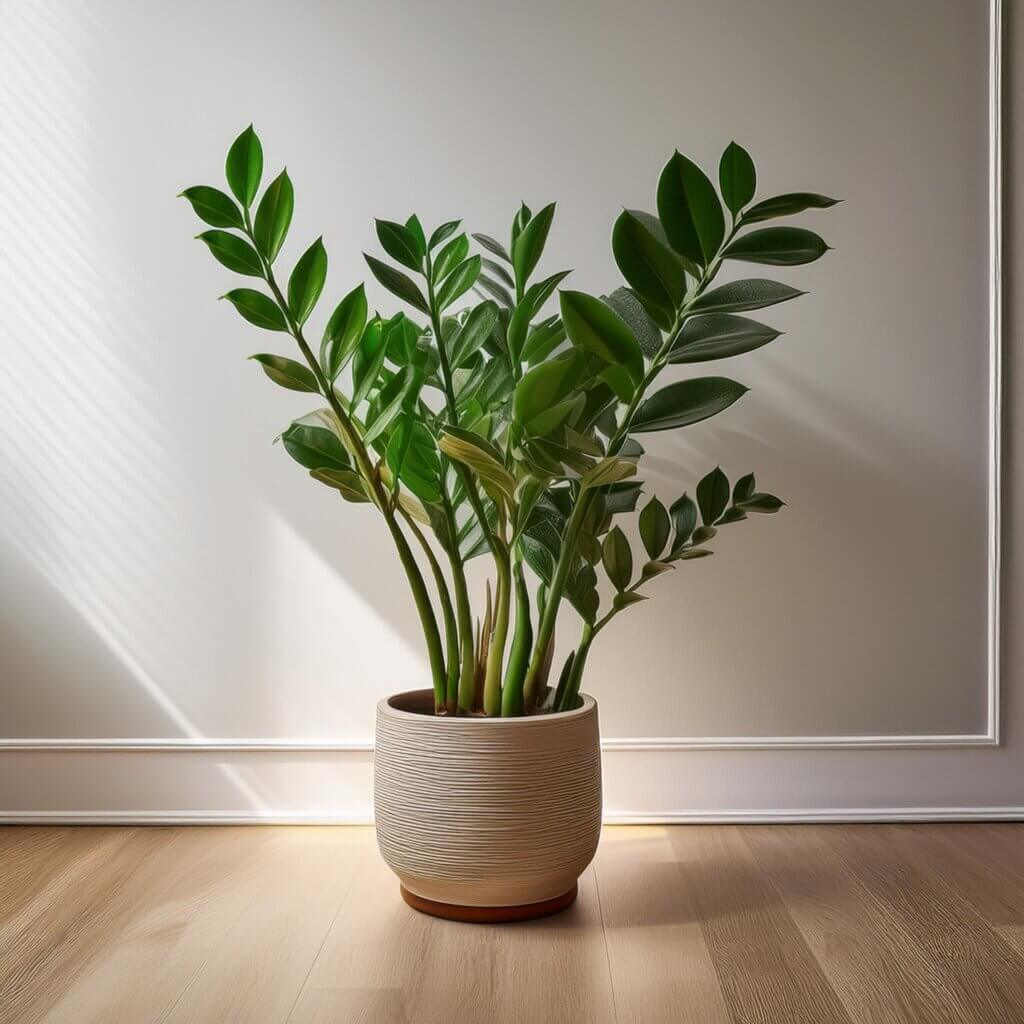
3. Spekboom (Portulacaria afra)
Spekboom, also known as the Elephant Bush, is a succulent that has gained popularity for its environmental benefits. This hardy plant is known for its ability to absorb high levels of carbon dioxide, making it a powerful tool in the fight against climate change. Its small, round leaves and dense, bushy growth make it an attractive option for both indoor and outdoor settings. Spekboom is also drought-tolerant, requiring minimal water, which makes it an ideal choice for those looking to conserve water or who live in drier climates.
Spekboom thrives in bright, indirect light but can also handle direct sunlight, making it a versatile plant for various indoor locations. It prefers well-draining soil and should be watered sparingly, especially during the cooler months. In addition to its environmental benefits, Spekboom is also edible and has been traditionally used in South African cuisine and medicine. Its ability to purify the air and its resilience in different environments make it a must-have for any indoor garden. To keep a healthy attractive plant, make sure your Spekboom gets enough light if you grow it as an indoor plant. Spekboom is one of the easy-to-propagate houseplants for beginners.
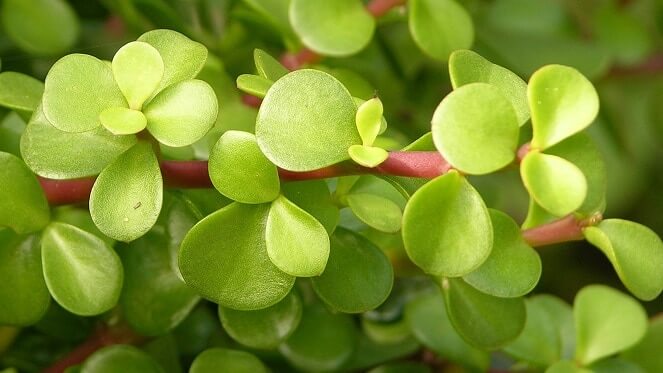
4. Fiddle Leaf Fig (Ficus lyrata)
The Fiddle Leaf Fig has become a trendy house plant, often featured in interior design magazines and social media posts. Its large, paddle-shaped leaves and tall stature make it a striking addition to any room. This plant is particularly well-suited for bright, open spaces where it can receive plenty of indirect light. The Fiddle Leaf Fig can grow quite tall, making it an excellent choice for filling vertical space in a living room or hallway.
While the Fiddle Leaf Fig is a bit more demanding in terms of care compared to some other house plants, its stunning appearance makes the effort worthwhile. It requires consistent watering, with the soil kept moist but not waterlogged. Overwatering or poor drainage can lead to root rot, so it’s important to ensure the plant’s pot has good drainage and to allow the top inch of soil to dry out between waterings. Regularly rotating the plant will help it grow evenly and prevent it from leaning towards the light. With proper care, the Fiddle Leaf Fig can become a long-lasting, dramatic feature in your home. make sure you take the time to look after these guys, once they drop thier leaves they become unatractive qiuckly. See the full plant guide for Fiddle Leaf Fig here
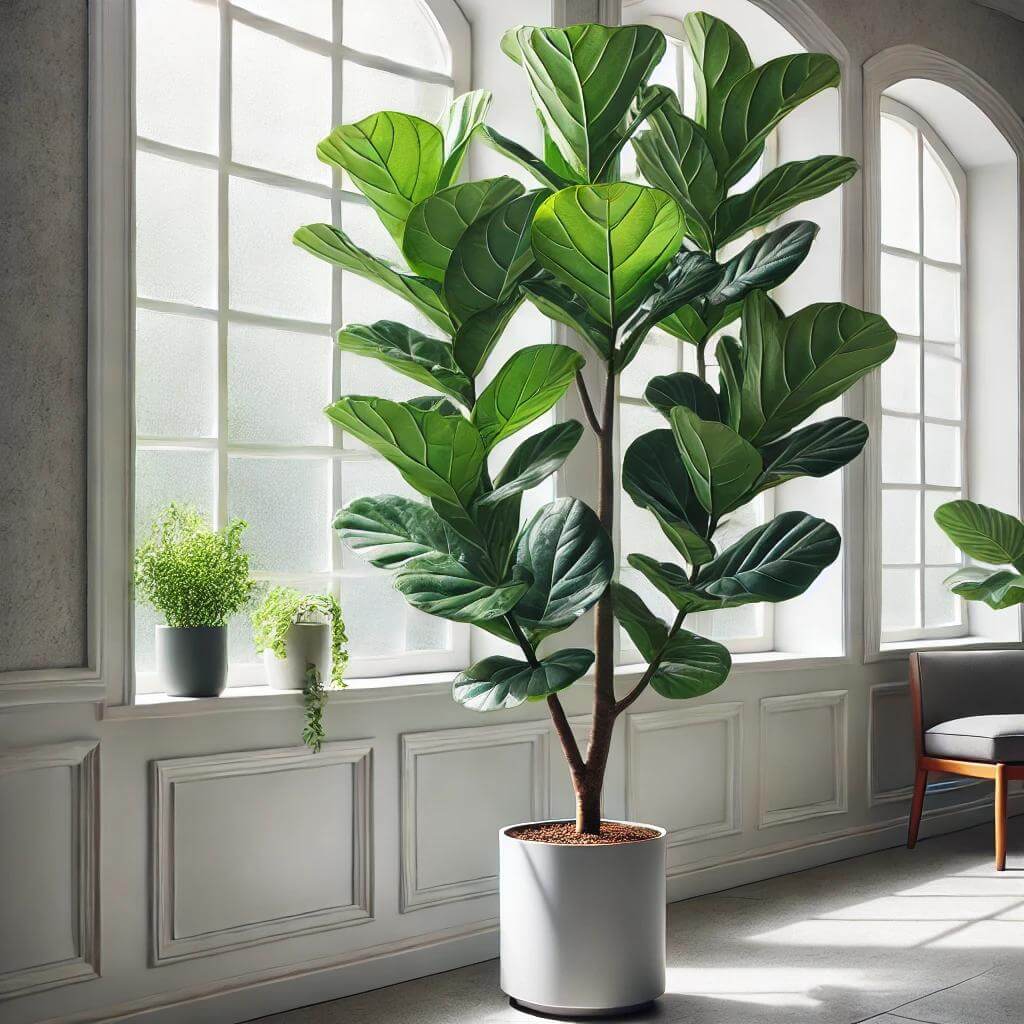
5. Monstera Deliciosa (Delicious Monster)
The Monstera Deliciosa, commonly known as the Delicious Monster or Swiss Cheese Plant, is famous for its large, glossy leaves that develop characteristic holes and splits as they mature. This tropical plant adds a touch of the jungle to any indoor space and is a favorite among plant enthusiasts for its bold appearance and easy care requirements. Monstera thrives in bright, indirect light and can tolerate some low light, although its growth may slow down.
Caring for a Monstera Deliciosa involves regular watering and ensuring that the soil remains slightly moist, but not soggy. It’s important to allow the top few centimeters of soil to dry out between waterings to prevent root rot. The plant’s large leaves can accumulate dust, so occasional wiping with a damp cloth will keep them looking their best. As Monstera can grow quite large, it’s ideal for spacious rooms where it can spread out and make a statement. See the full Delicious Monster plant guide here
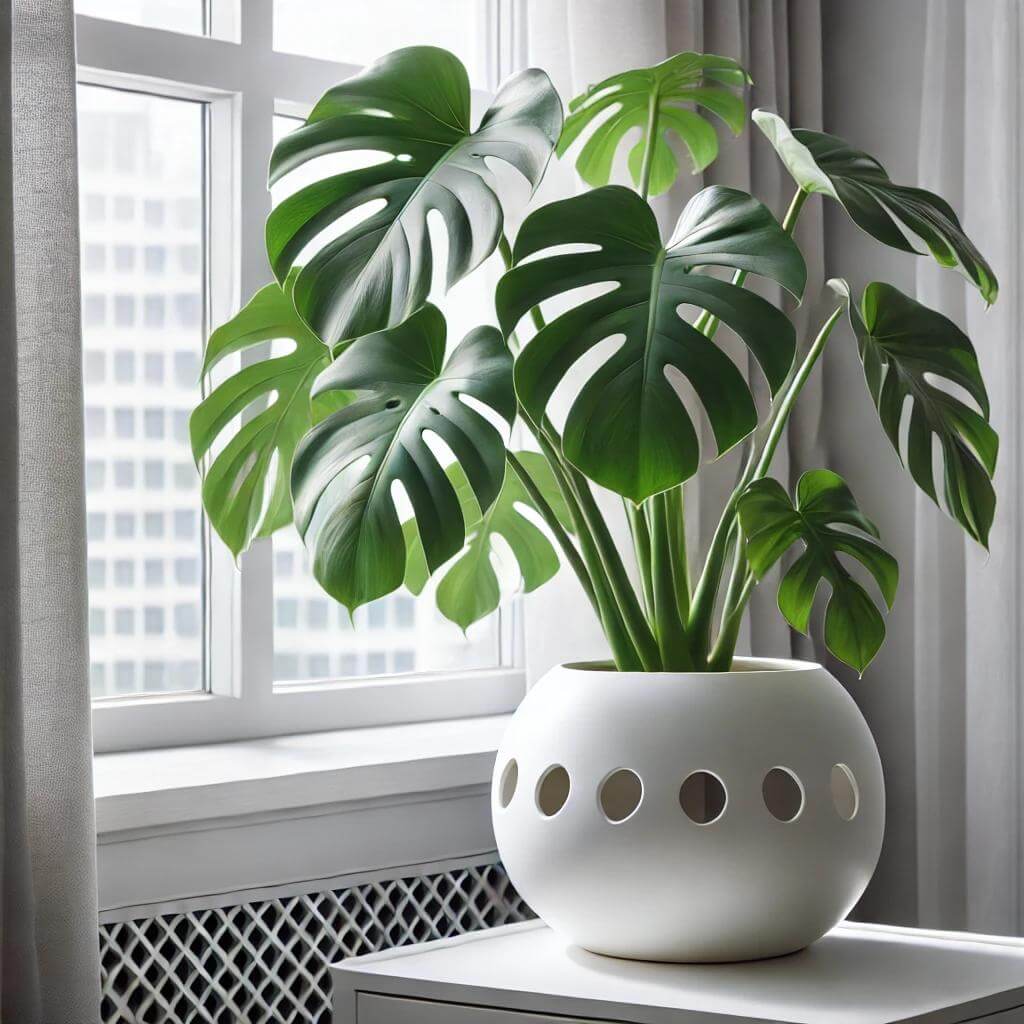
6. Rubber Plant (Ficus elastica)
The Rubber Plant is a classic house plant known for its broad, glossy leaves and easy-going nature. Available in a variety of colors, from deep burgundy to variegated green, the Rubber Plant can fit into any interior design scheme. It is a low-maintenance plant that prefers bright, indirect light but can also tolerate lower light conditions, making it suitable for most rooms in the house.
To care for a Rubber Plant, keep the soil slightly moist, but allow the top layer to dry out between watering. Overwatering can lead to yellowing leaves and root rot, so it’s crucial to avoid letting the plant sit in water. The Rubber Plant can grow quite tall, so it’s ideal for adding height and greenery to living rooms, offices, or hallways. Its air-purifying properties also make it a great choice for improving indoor air quality.
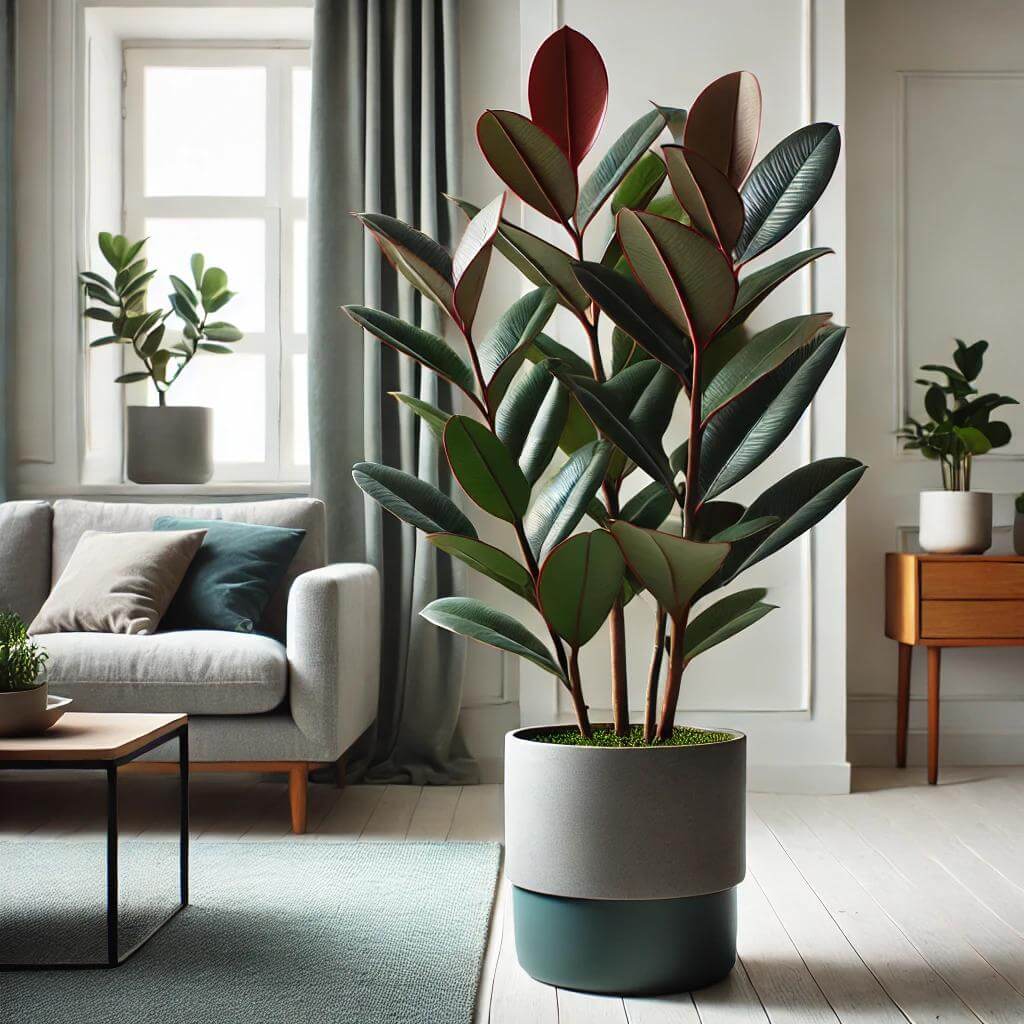
7. Pothos (Epipremnum aureum)
Pothos, also known as Devil’s Ivy, is a versatile and resilient house plant that is perfect for beginners. With its trailing vines and heart-shaped leaves, Pothos adds a touch of green to any room and is especially effective in hanging baskets or on high shelves where its vines can cascade down. Pothos is also known for its air-purifying abilities, making it a healthy addition to your indoor space.
Caring for Pothos is easy. It thrives in a variety of lighting conditions, from low light to bright, indirect light, and only needs to be watered when the soil is dry. Pothos is also tolerant of occasional neglect, making it an ideal plant for busy individuals. Its ability to remove toxins such as formaldehyde and benzene from the air adds to its appeal as a practical and decorative indoor plant.
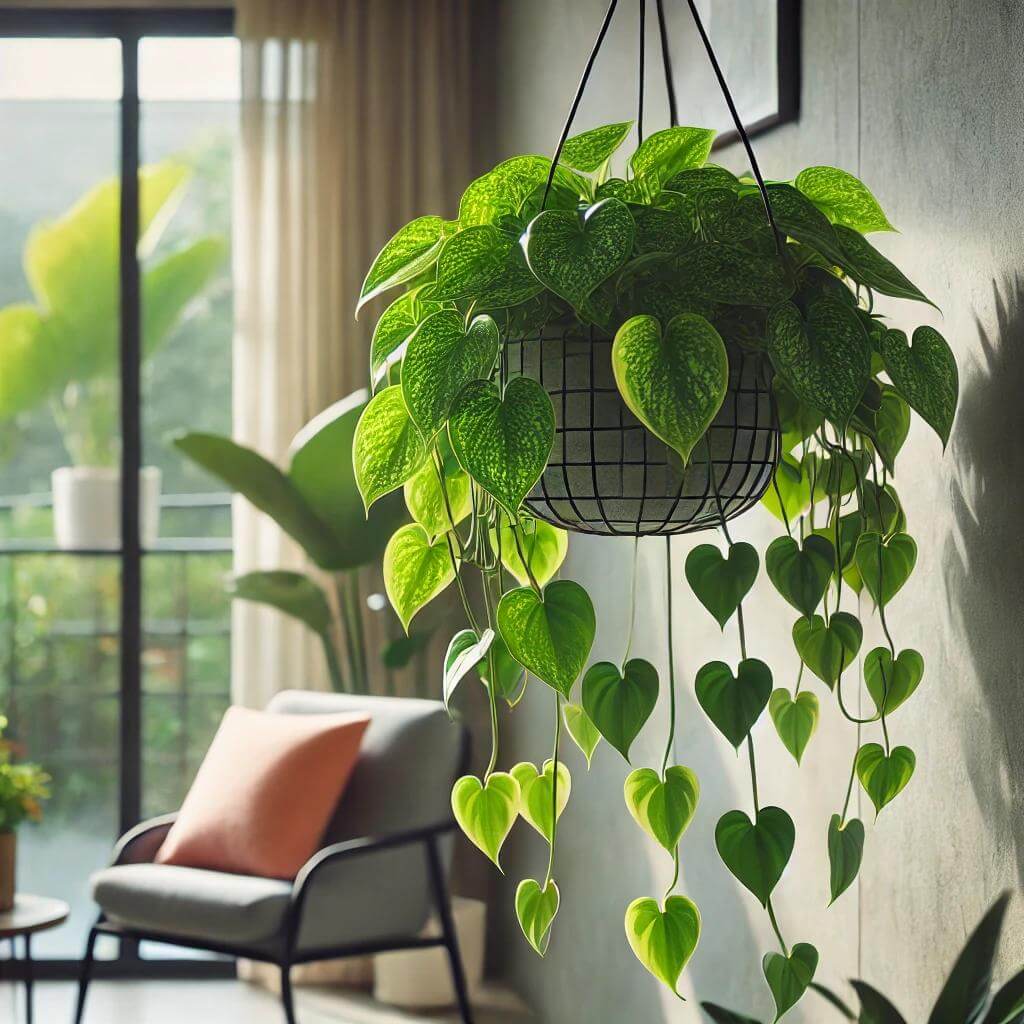
8. Spider Plant (Chlorophytum comosum)
The Spider Plant is a beloved house plant known for its arching leaves and ability to produce small “pups” or baby plants that dangle from the mother plant. This plant is incredibly easy to care for, making it a great choice for those new to indoor gardening. Spider Plants thrive in bright, indirect light but are also adaptable to lower light conditions, making them suitable for various locations around the home.
Watering a Spider Plant is simple. Keep the soil slightly moist, but not waterlogged, and reduce watering during the winter months when the plant’s growth slows down. The Spider Plant’s air-purifying properties and ability to remove pollutants like formaldehyde from the air make it an excellent choice for bedrooms, offices, or kitchens. Its cascading growth habit also makes it ideal for hanging baskets or as a statement plant on a high shelf.
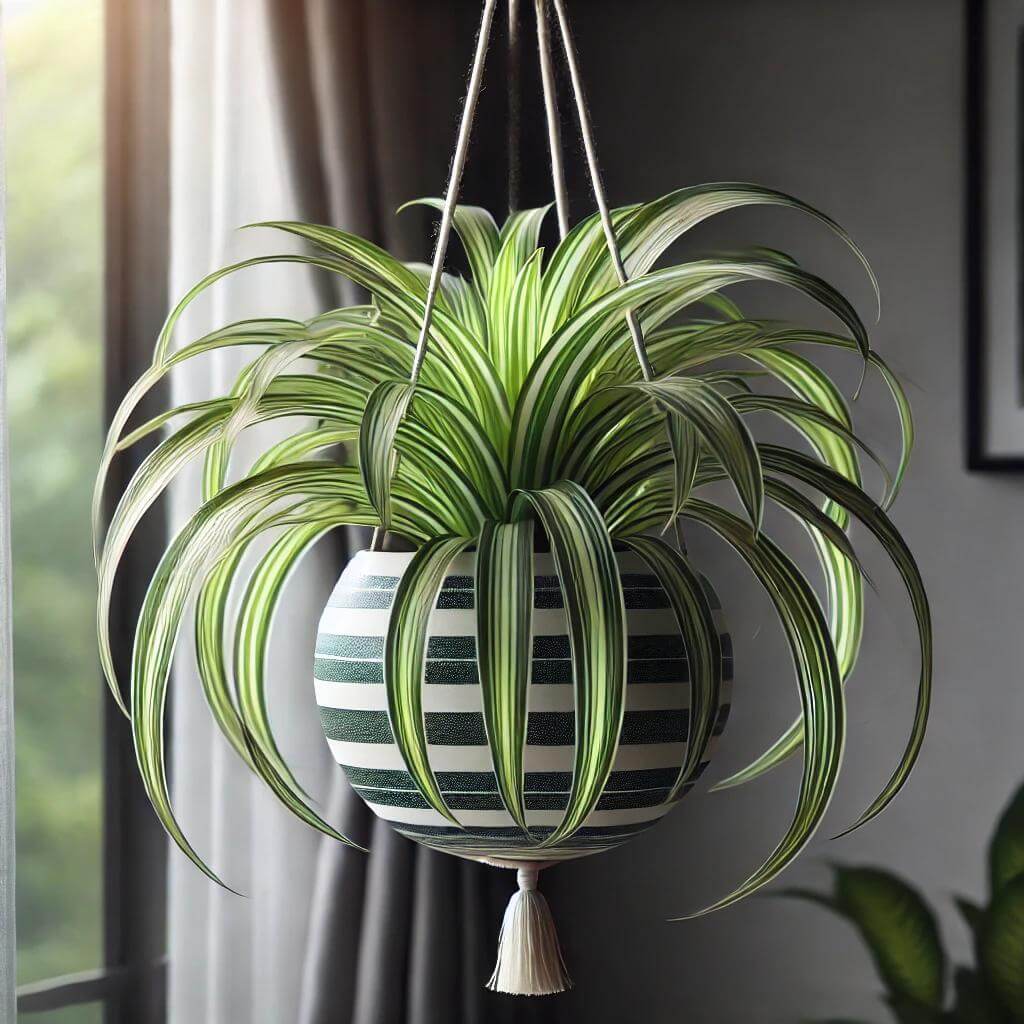
9. Peace Lily (Spathiphyllum)
The Peace Lily is a popular choice for indoor spaces due to its elegant white blooms and lush green foliage. This plant is particularly known for its ability to thrive in low-light conditions, making it ideal for darker rooms or corners that receive little natural sunlight. Peace Lilies are also excellent air purifiers, capable of removing toxins such as benzene, formaldehyde, and carbon monoxide from the air, which contributes to a healthier living environment. Their serene appearance and low maintenance needs make them a favorite among plant lovers who seek both beauty and functionality in their indoor plants.
Caring for a Peace Lily is relatively straightforward. These plants prefer consistently moist soil, but they do not tolerate being waterlogged, so it’s important to ensure good drainage. Watering once a week is usually sufficient, though they may need more frequent watering in the warmer months.

10. Chinese Evergreen (Aglaonema)
Chinese Evergreen is a versatile and resilient plant that can adapt to a wide range of indoor conditions, making it a perfect choice for beginners and experienced plant owners alike. With its striking, variegated leaves that often feature shades of green, silver, and red, this plant adds a pop of color to any room. It is also known for its ability to tolerate low light and its capacity to filter air pollutants, which helps to improve indoor air quality. Chinese Evergreens are particularly suited for offices, bedrooms, and other areas with limited sunlight.
This plant is incredibly easy to care for. It requires watering only when the top layer of soil feels dry to the touch, making it forgiving if you occasionally forget to water it. Chinese Evergreens prefer moderate humidity and can benefit from occasional misting, especially in drier environments. They are also slow-growing, so they won’t outgrow their space quickly, making them ideal for maintaining a tidy and manageable indoor garden. With minimal care, the Chinese Evergreen can thrive for years, adding long-lasting beauty and health benefits to your home. See the full Chinese Evergreen (Aglaonema) plant guide here.

11. Dracaena Marginata (Dragon Tree)
The Dracaena Marginata, commonly known as the Dragon Tree, is a striking indoor plant characterized by its slender trunk and spiky, variegated leaves that can range from green to deep red. This plant is known for its sculptural form and can add a touch of drama to any room with its bold, upright growth. Dracaenas are also known for their ability to filter toxins from the air, including formaldehyde and benzene, making them a great choice for improving indoor air quality. Their tall, tree-like structure makes them ideal for use as statement plants in living rooms or office spaces.
Caring for a Dracaena Marginata is straightforward. It prefers bright, indirect light but can tolerate lower light levels, although its growth may slow down in dimmer conditions. The soil should be kept slightly moist, but it’s important to avoid overwatering, as Dracaenas are susceptible to root rot. Water the plant thoroughly when the top inch of soil is dry, and ensure that the pot has good drainage. With its easy-going nature and dramatic appearance, the Dracaena Marginata is an excellent addition to any indoor plant collection. See the full Dracaena Marginata (Dragon Tree) plant guide here.
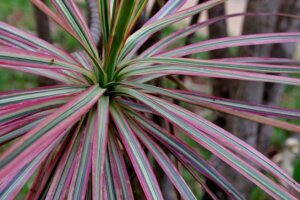
12. String of Pearls (Senecio rowleyanus)
String of Pearls is a unique and eye-catching plant known for its trailing stems adorned with small, spherical leaves that resemble pearls. This succulent is perfect for adding a touch of whimsy and elegance to your indoor garden. Its cascading growth habit makes it ideal for hanging planters or high shelves where its “pearls” can be displayed to full effect. String of Pearls is also relatively low-maintenance, making it a great choice for those who want a beautiful plant without the hassle of constant care.
This plant thrives in bright, indirect light and should be watered sparingly, as it is drought-tolerant. Allow the soil to dry out completely between waterings to prevent root rot, which is a common issue with succulents. During the growing season, you can water more frequently, but in the winter, it’s best to reduce watering to once a month. String of Pearls can be toxic to pets, so it should be placed out of reach of curious animals. With proper care, this plant will reward you with its distinctive beauty and easy-going nature, making it a delightful addition to your home.
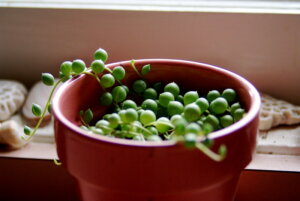
More Infromation and South African House Plant Problem Solving:
When considering adding South African house plants to your indoor space, you might have a few concerns or questions. Let’s address some of the common issues that people often face when searching for and caring for these plants.
Struggling with Low Light Conditions?
One of the most common challenges with indoor plants is ensuring they get enough light. Many South African house plants, like the ZZ Plant and Snake Plant, are incredibly tolerant of low light conditions, which makes them ideal for homes with limited natural light. However, if you find that your space is too dim even for these plants, consider placing them near a north-facing window where they can receive indirect light, or supplementing with artificial grow lights. Remember, too much direct sunlight can be harmful to some plants, so finding the right balance is key.
Worried About Overwatering House Plants?
Overwatering is a frequent concern, especially for beginners. South African house plants like the Snake Plant, ZZ Plant, and Spekboom are particularly drought-tolerant, meaning they prefer to dry out completely between waterings. If you’re unsure when to water, it’s better to err on the side of caution. Use a moisture meter or simply check the top inch of soil; if it’s dry, it’s time to water. Always ensure your pots have good drainage to prevent water from pooling at the bottom, which can lead to root rot.
Not Sure Which Plants Can Tolerate Your Indoor Environment?
Every home is different, and not all plants will thrive in every environment. If your home has fluctuating temperatures or you tend to keep your space cooler, consider plants like the Chinese Evergreen or Peace Lily, which are more forgiving and can tolerate a range of indoor climates. If humidity is a concern, placing your plants on a tray with pebbles and water or using a humidifier can help mimic the more humid environments that some plants, like the Fiddle Leaf Fig, prefer.
Concerned About Pets and Plants Coexisting?
If you have pets, you might be worried about the toxicity of certain plants. While many popular house plants are safe, others like the Peace Lily and ZZ Plant can be toxic if ingested by pets. To keep your pets safe, consider placing toxic plants out of reach, using hanging planters, or choosing non-toxic plants like the Spider Plant or African Violet. Always research a plant’s safety profile before bringing it into a home with animals. Here is more iformation on houseplants that are toxic to cats
Finding It Difficult to Keep House Plants Alive?
If you’ve struggled with keeping plants alive in the past, start with resilient, low-maintenance options like the Snake Plant or Pothos. These plants are known for their hardiness and can tolerate some neglect. Focus on understanding the basics of plant care—light, water, and soil conditions—and gradually expand your collection as you become more confident. Additionally, using self-watering pots or setting up reminders to check on your plants can help ensure they receive the care they need without overwhelming you.
By considering these factors and starting with the right plants, you can successfully cultivate a thriving indoor garden with South African house plants that not only beautify your space but also contribute to a healthier, more vibrant home environment.
South African House Plant Q and A
What is the good luck plant in South Africa?
In South Africa, Spekboom (Portulacaria afra) is often considered a good luck plant. Not only is it admired for its resilience and air-purifying qualities, but it also plays a significant role in environmental conservation by absorbing large amounts of carbon dioxide. Due to its association with sustainability and positive environmental impact, many believe it brings good fortune and prosperity.
What is the most popular plant in South Africa?
The Fiddle Leaf Fig (Ficus lyrata) has become one of the most popular plants in South Africa, as well as globally. Its large, glossy leaves and elegant stature make it a favorite for both homes and offices. This plant’s ability to thrive in bright, indirect light and its striking appearance have solidified its position as a top choice among plant enthusiasts.
What is the best plant to keep indoor?
The Snake Plant (Sansevieria trifasciata) is considered one of the best indoor plants due to its hardiness, low maintenance, and air-purifying qualities. It can tolerate a wide range of light conditions, from low to bright indirect light, and requires minimal watering. This makes it a perfect choice for both beginners and seasoned plant owners.
What is the best lucky indoor plant?
The Peace Lily (Spathiphyllum) is often regarded as a lucky indoor plant because of its ability to purify the air and bring a sense of peace and tranquility to the home. Its elegant white flowers are believed to symbolize harmony and calm, making it a popular choice for those seeking positive energy and good luck indoors.
What is the miracle plant in South Africa?
The Spekboom is often referred to as the “miracle plant” in South Africa. Its exceptional ability to sequester carbon dioxide has earned it this title. Beyond its environmental benefits, Spekboom is also edible, has medicinal uses, and thrives in arid conditions, making it a truly remarkable plant for both indoor and outdoor settings.
What is lucky house plant?
The Money Plant (Pothos) is commonly associated with good fortune and wealth. In South Africa, as well as in many cultures worldwide, this plant is believed to attract prosperity and abundance. With its trailing vines and heart-shaped leaves, the Money Plant is not only aesthetically pleasing but also regarded as a symbol of financial success when placed in homes and offices.
Buy South African House Plants and More Helpful Resources
Atrium Plants
A collection of indoor plants with detailed care tips and a variety of species for South African homes.
https://atriumplants.co.za/collections/indoor-plantsPlantify
An online shop featuring large indoor plants with a focus on unique and trendy plant varieties.
https://plantify.co.za/collections/plantify-largeStodels
A wide selection of indoor plants for different light conditions, perfect for home and office spaces.
https://www.stodels.com/product-category/plants-by-type/indoor-plants/Cape Garden Centre
Offers a range of indoor plants, including easy-to-care-for options for various lighting environments.
https://www.capegardencentre.co.za/collections/indoor-plantsLifestyle Home Garden
Features articles on trending indoor plants and tips for creating a lush indoor jungle.
https://lifestyle.co.za/trendiest-indoor-plants/Plantland
A detailed catalog of indoor plants for sale with care instructions and plant-specific information.
https://plantland.co.za/Shop/plants/indoor-plants/
Conclusion
South African house plants provide a wonderful way to enhance the beauty and health of your indoor spaces. From the resilient Snake Plant and the elegant Peace Lily to the unique String of Pearls, these plants are well-suited to a variety of environments and care levels. Whether you are a novice gardener or an experienced plant enthusiast, there is a South African house plant that will thrive in your home. By understanding the specific needs of each plant and providing the right conditions, you can create a thriving indoor garden that brings life, color, and well-being into your living space.
Start your indoor gardening journey today and enjoy the numerous benefits these plants have to offer.

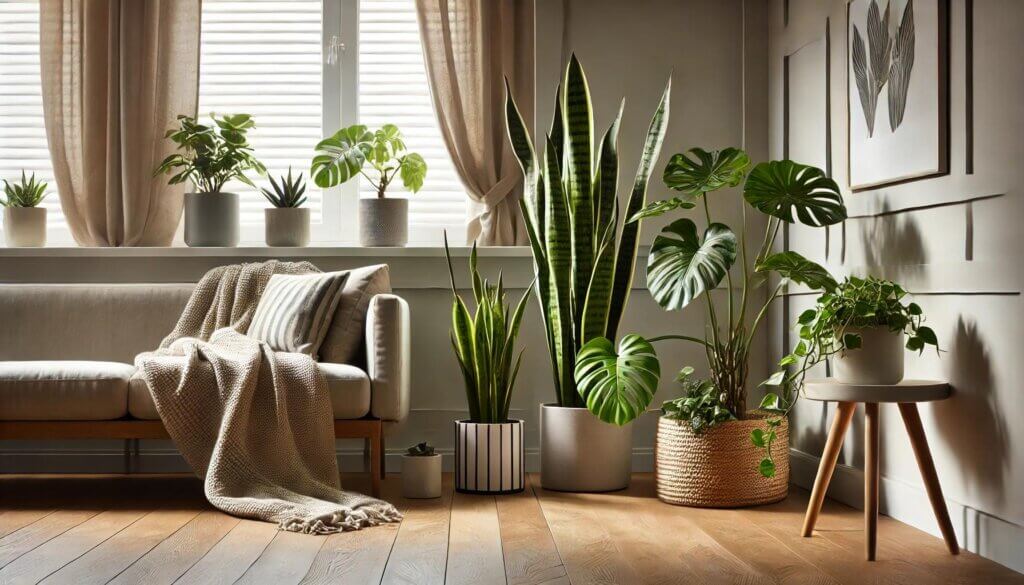

This site was very helpful to me but my concern is which plants need to root first before putting in dirt? I have one plant with speckles on it and has not rooted after three weeks. Does it need roots before putting in dirt or just wait a little longer?
You are welcome to sharte a photo for more detailed advice?
Some plants can be propagated in water or damp environments before transferring them to soil, but whether a plant needs to root first depends on the species. Generally, cuttings of certain plants should develop roots before being planted in dirt to ensure they can absorb nutrients and water.
Common Plants that Need to Root Before Planting in Soil:
Pothos
Philodendron
Spider Plant
Coleus
Mint and other herbs
If your plant has speckles on its leaves and hasn’t rooted after three weeks, it may indicate a health issue like overwatering, underwatering, or disease. Here’s what you can do:
Check the Cutting: Gently tug on the cutting. If it’s mushy or blackened at the bottom, it could be rotting, and you may need to restart with a fresh cutting.
Environment: Ensure the water (if rooting in water) is clean and changed every few days. Make sure the cutting is in a bright but indirect light, which promotes healthy rooting.
Patience: Some plants take longer than others to root. If the cutting is still firm and healthy, give it more time.
If you can tell me what plant you’re working with, I can offer more specific advice.